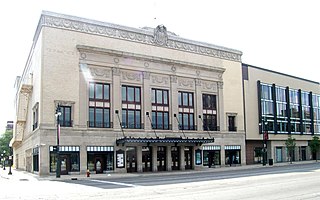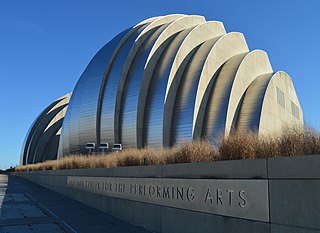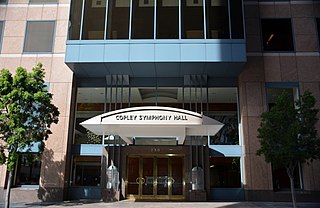
Symphony Hall is a concert hall located at 301 Massachusetts Avenue in Boston, Massachusetts, opened in 1900. Designed by the architectural firm McKim, Mead and White, it was built for the Boston Symphony Orchestra, which continues to make the hall its home. It can accommodate an audience of 2,625. The hall was designated a U.S. National Historic Landmark in 1999 and is a pending Boston Landmark. It was then noted that "Symphony Hall remains, acoustically, among the top three concert halls in the world, and is considered the finest in the United States." Symphony Hall, located one block from Berklee College of Music to the north and one block from the New England Conservatory to the south, also serves as home to the Boston Pops Orchestra as well as the site of many concerts of the Handel and Haydn Society.

Symphony Hall is a 2,262 seat concert venue in Birmingham, England. It was officially opened by Queen Elizabeth II on 12 June 1991, although it had been in use since 15 April 1991. It is home to the City of Birmingham Symphony Orchestra and hosts around 270 events a year. It was completed at a cost of £30 million. The hall's interior is modelled on the Musikverein in Vienna and the Concertgebouw in Amsterdam. The venue, managed alongside Town Hall, presents a programme of jazz, world, folk, rock, pop and classical concerts, organ recitals, spoken word, dance, comedy, educational and community performances, and is also used for conferences and business events as part of the International Convention Centre.

Orchestra Hall is an elaborate concert hall in the United States, located at 3711 Woodward Avenue in Midtown Detroit, Michigan. The hall is renowned for its superior acoustic properties and serves as the home of the internationally known Detroit Symphony Orchestra (DSO), the fourth oldest orchestra in the United States. With the creation of an adjoining auditorium for jazz and chamber music in 2003, Orchestra Hall became part of the Max M. and Marjorie S. Fisher Music Center. It was listed on the National Register of Historic Places in 1971.

Bridgestone Arena is a multi-purpose indoor arena in downtown Nashville, Tennessee, United States. Completed in 1996, it is the home of the Nashville Predators of the National Hockey League.

Louise M. Davies Symphony Hall is the concert hall component of the San Francisco War Memorial and Performing Arts Center in San Francisco, California. The 2,743-seat hall was completed in 1980 at a cost of US$28 million to give the San Francisco Symphony a permanent home.

The Morton H. Meyerson Symphony Center is a concert hall located in the Arts District of downtown Dallas, Texas (USA). Ranked one of the world's greatest orchestra halls, it was designed by architect I.M. Pei and acoustician Russell Johnson's Artec Consultants, Inc. The structural engineers for this project was Leslie E. Robertson Associates, and opened in September 1989.

Martha Robinson Rivers Ingram is an American billionaire businesswoman and philanthropist. In 1995, Ingram succeeded her late husband as chairman and chief executive officer (CEO) of Ingram Industries, one of America's largest privately-held companies. She is the co-author of three books, including two biographies and a history of the performing arts in Nashville, Tennessee.

The Suntory Hall (サントリーホール) is a concert venue in the central Akasaka district of Tokyo, Japan. Part of the Ark Hills complex, it consists of a main concert hall, widely considered one of the finest in the world for its acoustics — indeed Herbert von Karajan called it “a jewel box of sound” — and a smaller side-hall for chamber music. Its roof is an extended, tiered, landscape garden. Construction began in the late 1970s and the facility opened in October 1986.

The New World Center is a concert hall in the South Beach section of Miami Beach, Florida, designed by Frank Gehry. It is the home of the New World Symphony, with a capacity of 756 seats. It opened in January 2011.

The Perth Concert Hall is a concert hall located in Perth, the capital of the Australian state of Western Australia. Owned by the City of Perth, the hall is the main venue of the West Australian Symphony Orchestra, and also hosts a number of other events and performances. The building itself is located in Perth's central business district, adjacent to the Supreme Court Gardens and Government House. The building has two façades: facing north over St Georges Terrace, and facing south over the Swan River.

The Nashville Symphony is an American symphony orchestra, based in Nashville, Tennessee. The orchestra is resident at the Schermerhorn Symphony Center.

The Kauffman Center for the Performing Arts is a performing arts center in downtown Kansas City, Missouri, USA, at 16th and Broadway, near the Power & Light District, the T-Mobile Center and the Crossroads Arts District. Its construction was a major part of the ongoing redevelopment of downtown Kansas City.

The Donna & Marvin Schwartz Center for Performing Arts is a 90,000-square-foot (8,400 m2) multi-discipline performing arts facility on the campus of Emory University in Atlanta, Georgia. Completed in early 2003, the Schwartz Center provides a multidisciplinary teaching and performance center for the performing arts programs at Emory including dance, music, and theater. The centerpiece of the center is the 825-seat Cherry Logan Emerson Concert Hall featuring a custom-built Daniel Jaeckel Opus 45 pipe organ with fifty-four stops and 3,605 pipes in a cherry-wood case. The concert hall was designed in part by renowned acousticians Kirkegaard and Associates. The $36.9 million structure was designed by lead architect Michael Dennis in association with Howard-Montgomery-Steger and Smallwood, Reynolds, Stewart, Stewart.

The Blair School of Music, located in Nashville, Tennessee, provides a conservatory-caliber undergraduate education in music performance, composition, or integrated music studies within the context of a major research university, Vanderbilt University. Blair also provides music lessons, classes and ensembles to over 800 precollege and adult students each semester. Blair is the youngest and smallest of Vanderbilt's ten constituent schools and colleges.

The Pinnacle at Symphony Place is a 29-story, office and retail skyscraper located in Nashville, Tennessee, in the city's SoBro district. Located adjacent to the Schermerhorn Symphony Center, the building officially opened on February 10, 2010. The building includes 520,000 square feet (48,000 m2) of Class A office space and 23,000 square feet (2,100 m2) of retail space.

Bilkent Concert Hall is a performing arts center in Turkey. It is located within the Bilkent University campus in Ankara. Home to the Bilkent Symphony Orchestra, the building hosts over 80 concerts per year. Besides the concert hall itself, the building houses seminar rooms, academic staff offices, classrooms and studios for the university's Faculty of Music and Performance Arts, together with an arena theatre for performances from theatre studies students.


The Philharmonie de Paris is a complex of concert halls in Paris, France. The buildings also house exhibition spaces and rehearsal rooms. The main buildings are all located in the Parc de la Villette at the northeastern edge of Paris in the 19th arrondissement. At the core of this set of spaces is the symphonic concert hall of 2,400 seats designed by Jean Nouvel and opened in January 2015. Its construction had been postponed for about twenty years to complete the current musical institution la Cité de la Musique designed by Christian de Portzamparc and opened in 1995. Mainly dedicated to symphonic concerts, the Philharmonie de Paris also present other forms of music such as jazz and world music.
Once Upon a Castle is a symphonie concertante for organ and orchestra composed in 2003 and revised in 2015 by American composer Michael Daugherty. The music is inspired by both the life and times of American media mogul William Randolph Hearst, Hearst Castle, and the Hollywood lore of Charles Foster Kane, a fictional character based on Hearst in the movie Citizen Kane.




















